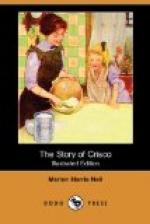[Illustration]
CANDIES
[Illustration]
It is well to have a confectioner’s thermometer for candy making, so that the syrup may be removed from the fire at exactly the right degree. Such thermometers are made of wood, brass, or copper, and the degrees on them should mark not less than 350 deg.. A thermometer always should be gently lowered into the boiling sugar. When not in use, it should be kept hanging on a nail or hook. When required for candy making, place thermometer in pitcher of warm water, so that it may rise gradually, and return it to the warm water on removing it from the hot candy. This dissolves the clinging candy and protects the tube from breaking. The wooden thermometer can be used to stir with, and is very easy to keep clean.
If there is no thermometer handy it is better to make a list of the various stages in sugar boiling, and learn how to test the sugar. First there is the “thread” (216 deg. F. to 218 deg. F.) This is reached when, on dipping the finger and thumb first into cold water and then into the syrup, you can draw them apart, and an unbroken thread is formed, which gradually can be drawn wider apart on further testing as the degree of boiling is completed.
The next is the “pearl” (220 deg. F.) To see if the syrup has reached this stage, after the sugar has dissolved let it boil for eight to ten minutes, then dip a wooden skewer into the syrup to obtain a drop of it. Dip the finger and thumb into cold water, then rub the drop of syrup between them; if it feels smooth, the syrup has reached the desired stage. The next is the “blow” (230 deg. F.) Dip a spoon into the sugar, shake it, and blow through the holes; if sparks of light or bubbles be seen, you may be sure of the blow. This is followed by the “feather” (235 deg. F.) To test this, dip a spoon into the boiling syrup, and when it may be blown easily from the spoon in long shreds it has reached the right degree.
[Illustration]
Next comes the “ball” (240 deg. F. to 250 deg. F.) Dip the finger and thumb first into cold water, and then into the syrup, the latter then can be rolled into a soft ball between the finger and thumb. A little longer boiling gives the hard ball. This in turn is succeeded by the “crack” (290 deg. F. to 300 deg. F.) To test this, drop a little of the syrup into cold water; if it then breaks off sharp and crisp it has reached the crack. The final stage is the “caramel” (350 deg. F.) which comes very quickly after the crack, the syrup becoming first a pale yellow, and then a rich golden brown, and finally black or burnt. When it first reaches this stage the pan should be removed from the fire, a little lemon juice or water added, and then the whole reboiled to the proper stage or shade. To prevent granulation, it often is advisable to add a pinch of cream of tartar, to the pound of sugar.




